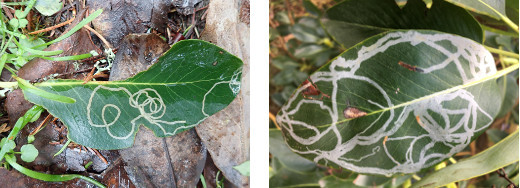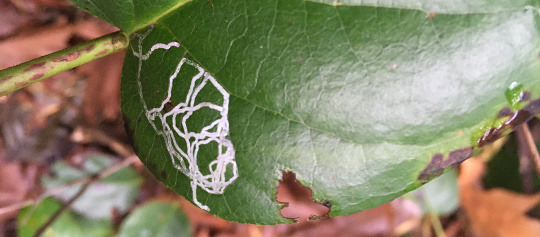#marmara arbutiella
Text

06/05/2023 Caterpillar making Nonstandard Life Choices.
Marmara arbutiella is a tiny caterpillar that lives inside arbutus leaves. It leaves the waxy top and bottom layer of the leaf intact for shelter and eats a tunnel through the juicy middle layer, writing a gleaming silvery spiral into the flesh of the leaf.
The Blue Haired Girlfriend found this Caterpillar of Nonstandard Life Choices living in a salal leaf instead of an arbutus lead. These eccentrics turn up occasionally in a small area that includes our island.
We know the salal-dwellers are Marmara arbutiella, because someone sent a salal leaf with a caterpillar in it to Charley Eiseman (see @lies's Charley Eiseman Appreciation Post) and he got it DNA barcoded.
But nobody has observed a salal-dweller outside the leaf. We don't know if it has morphological differences from the arbutus-dwellers as an adult moth, like maybe a new subspecies is starting to branch off here.
So we picked the leaf and put it in a jar with a little moss to hold moisture. Hopefully there's still a Caterpillar of Nonstandard Life Choices in it, and the caterpillar will crawl out of the leaf, make a cocoon, and emerge into an adult we can send to Charley Eiseman.
The cocoon is pretty exciting too, described in the poetic words of Wagner, Loose, Fitzgerald, De Benedictis, and Davis:
The larvae exhibit a fascinating cocoon-spinning behavior which involves prolonged ornamentation of the cocoon with dozens of anally extruded compartmentalized bubbles, each of which is individually wrapped in silk and pushed through to the outer cocoon surface.
I, for one, am delighted at the prospect of a cocoon containing a moth nobody has ever seen, festively garlanded in silk-wrapped bug farts.
#daily#leaf miner#marmara arbutiella#moth#another fine post about animal poop#animals farts really but I don't have a tag for that#spoilers from future everwest: caterpillar had already left leaf#we did not get to see a fart cocoon or nonstandard life choices moth
145 notes
·
View notes
Photo



21/09/2020 Bark beetle carvings.
We had a windstorm last night that broke a dead tree near the driveway and left it leaning ominously on another tree. The Blue Haired Girlfriend roped it and brought it the rest of the way to the ground safely. There we could see that it had been infested by the larvae of bark beetles, who carve themselves tunnels to live in under the bark of drying trees.
When I was a kid, my siblings and I used to find beetle-carved sticks, marked with intricate spirals or loose meandering labyrinths, in the forest sometimes. We called them "wizard staves" (I was the sort of kid who was pedantic about the plural of "staff,” I'm afraid) and tried to make sense of the carvings to figure out what sort of wizard they were for.
Sometimes you'd be peeling the bark off a stick for fun and the carvings were already there, under the sealed intact bark, which was obviously magic. We thought the forest itself wrote them, somehow, that they were a record of what the forest was thinking. We made crayon rubbings and taped them to walls for comparison and tried to figure out if the same pattern appeared on different staves.
I still adore bark beetle carvings. Not entirely sure they aren't the forest writing on itself in a language we can't read yet.

In other Calligraphically Inclined Insect news this week, these are leaf miners. They're tiny moths whose caterpillars live inside leaves and eat the soft bits, but leave the outside skin of the leaf intact. The pale markings are written in the leaf wherever the leaf miner has been, another way the forest draws on itself. These are Marmara arbutiella living in arbutus leaves.

And this ... is a Mystery Leafminer we found! It's in a salal leaf, but we couldn't find any records of leaf miners living in salal. We talked to an entomologist, who says that other people on the closest bits of the mainland have also found leaf miners living in salal. He got someone to send one off for DNA barcoding, and it turned out (probably) to also be Marmara arbutiella, just living in a different plant.
But it's only been found a handful of times in a small area, and nobody has ever seen the moth it turns into. Do the salal-calligraphers look or act different than the arbutus-calligraphers? Is a new species branching off right here? Nobody knows yet.
So next spring, when they're ready to come out of the leaves and make cocoons, we’ll find a salal-leaf calligrapher, put the whole leaf in an insect jar, see what moth it turns into, and mail it to the entomologist.
A different sort of magic, but somewhere a child carefully organizing crayon rubbings of wizard staves by "spirallyness" definitely approves.
#daily#marmara arbutiella#curculionidae#writing this in february#time to collect some salal calligraphers#but can't find any#the general cussedness of whatever your study organism is
523 notes
·
View notes